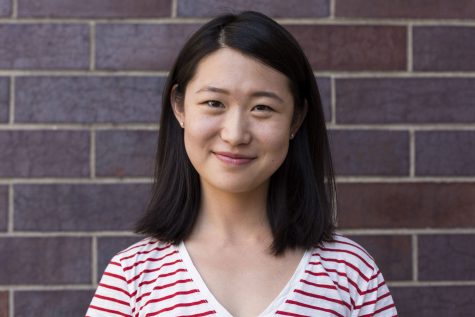Let Art Be Art in ‘Let X=X’
April 7, 2016
In such a digital age, it’s getting easier and easier for artists to break from traditional methods of artistic expression and manipulate their work exactly how they want it at any point in the creative process. This has caused much discussion about the role of digital manipulation in art and how it fits in with techniques that are sometimes meant to be so raw and unfiltered.
Curators Becky Nahom and Anthony Philip attempt to break this idea down by bringing together seven emerging artists for “Let X=X: New Voices in Digital Media,” a show examining the role of computer technology in contemporary art and how digital manipulation can offer new approaches to expression. Digital media is by nature different from traditional art mediums, so it is no surprise that the intention of these pieces seem cryptic at first glance.
Perhaps the most eye catching piece in the gallery is “Eye Eye” by Richard Dana. It is one of the purely abstract pieces, with no subject to make out, but the richly colored print can be appreciated as a compact and composition. A sweeping curve unites the richly patterned and visual information-laden image. Dana explains that his “art’s saturation is a reflection of the information and image saturation of contemporary society.” But supersaturated information and image are hard to absorb, even upon
much contemplation.
Cody Healey-Conelly’s collection of five small polaroids is also featured in the show. These prints are at once intriguing because the images printed are all deliberately distorted by the artist — a task not easily conceived of, because photos are
printed immediately after they are taken. Healey-Conelly might have been the only artist that was able to engage with the viewer by inciting the question of how was he able to manipulate a polaroid, and building the connection of how technology is incorporated into creative processes.
Perhaps one of the most hotly debated topics regarding digital creation is whether or not 3D printing will endanger the art of sculpting — or if 3D printed objects are even considered art. Another artist in the gallery, Vita Eruhimovitz, creates sculptures of black clouds that are digitally designed and then constructed using a 3D printer. These pieces illustrate the ways that technology facilitates the realization of artists’ ideas. It also asks the question of how technology is changing art — the cloud sculptures featured can be printed in under half an hour, but the process of creating the same sculpture would have taken several times longer if done by hand.
If one finds that the show is not particularly visually compelling, it’s because the attraction is in the processes that take place to produce the pieces. In contemporary art, the final image that viewers expect to appreciate is becoming more and more representative, the proof of a process. Process is where the real point of interest lies.
“Let X=X: New Voices in Digital Media” is on show through May 1 at Anthony Philip Fine Art at 56 Bogart Street, Brooklyn, New York 11206.
Email Qianqian Li at [email protected].













































































































































Worldglass • Apr 15, 2016 at 10:49 pm
Love the article. Went to the show.
The process is where the real point of interest lies…
The final products is the witness of an artist’s success and many times failures.
Amber • Apr 8, 2016 at 11:00 am
I love the title, I love the content. Great contributing writer!